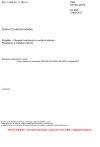Vánoční provoz a PF 2026
Vážení zákazníci,
aby bylo možné dodat objednané zboží před začátkem vánočních svátků, odešleme poslední várku zboží v tomto roce v pátek 19. prosince. Objednávky došlé po 10. hodině 19. prosince odešleme až 5. ledna 2026. Od 19. prosince do 2. ledna taktéž nebude možný osobní odběr objednaných norem.
Děkujeme za váš zájem v tomto roce,
přejeme vám hodně zdraví, pohody a úspěchů v roce 2026.
ČSN EN ISO 22675 (844020) Zrušená norma
Protetika - Zkoušení kotníkových a nožních náhrad - Požadavky a zkušební metody
Podívejte se na její náhradu.
Anotace obsahu normy
IMPORTANT - This International Standard is suitable for the assessment of the conformity of prosthetic ankle-foot devices and foot units with the strength requirements specified in 4.4 of ISO 22523:2006 (see NOTE 1). Prosthetic ankle-foot devices and foot units on the market, which have demonstrated their compliance with the strength requirements specified in 4.4 of ISO 22523:2006 through submission to the relevant tests of ISO 10328:2006, need not be retested to this International Standard.
WARNING - This International Standard is not suitable to serve as a guide for the selection of a specific ankle-foot device or foot unit in the prescription of an individual lower limb prosthesis! Any disregard of this warning can result in a safety risk for amputees.
This International Standard primarily specifies a cyclic test procedure for ankle-foot devices and foot units of external lower limb prostheses, distinguished by the potential to realistically simulate those loading conditions of the complete stance phase of walking from heel strike to toe-off that are relevant to the verification of performance requirements such as strength, durability and service life.
This potential is of particular importance for the assessment of the performance of a variety of recent designs of ankle-foot devices and foot units with specific characteristics that will only develop under realistic conditions of loading.
In addition, this International Standard specifies a static test procedure for prosthetic ankle-foot devices and foot units, consisting of a static proof test and a static ultimate strength test, distinguished, besides other features, (see NOTE 2) by the potential to generate heel and forefoot forces at lines of action conforming to those occurring at the instants of maximum heel and forefoot loading during the cyclic test.
The loading conditions addressed in the third paragraph are characterized by a loading profile determined by the resultant vector of the vertical and horizontal (A-P) ground reaction forces and by a locomotion profile determined by the tibia angle.
The test loading conditions specified in this International Standard are characterized by standardized formats of these loading and locomotion profiles, to be uniformly applied by the cyclic and static test procedures to each sample of ankle-foot device or foot unit submitted for test.
According to the concept of the tests of this International Standard, each sample of ankle-foot device or foot unit submitted for test is, nevertheless, free to develop its individual performance under load.
NOTE 1: The lines of action of the heel and forefoot forces generated by the static test procedure specified in this International Standard approach those determining the sagittal plane loading of the test loading conditions I and II for the principal structural tests specified in ISO 10328:2016, without changing the values of the angles of the heel and forefoot platform(s) for the structural tests on ankle-foot devices and foot units specified in ISO 10328:2016.
| Označení | ČSN EN ISO 22675 (844020) |
|---|---|
| Katalogové číslo | 501012 |
| Cena | 770 Kč770 |
| Datum schválení | 1. 1. 2017 |
| Datum účinnosti | 1. 2. 2017 |
| Jazyk | angličtina (obsahuje pouze anglický originál) |
| Počet stran | 108 stran formátu A4 |
| EAN kód | 8596135010127 |
| Norma byla zrušena k | 1. 11. 2025 |
| a nahrazena | ČSN EN ISO 22675 (844020) |
| Tato norma nahradila | ČSN EN ISO 22675 (844020) z května 2007 |
| Dostupnost | skladem (tisk na počkání) |


